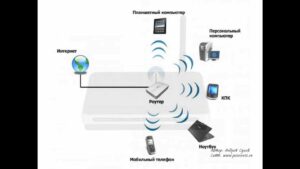Method 1: View connected devices through the router's web interface
The first and easiest way to find out the number of devices connected to your router is to view the list of connected devices through the router's web interface. To do this, you need to go to the router settings, which are usually located at address 192.
168.
0.
1 or 192.
168.
1.
1. In the 'Device List' or 'Connected Devices' section you will see a list of all devices that are currently connected to the router. This method also allows you to find out the IP addresses and MAC addresses of connected devices, which can be useful in network management and security settings. If you find devices on the list that you don't recognize, it could be a sign that something is wrong with your network. However, it is worth noting that this method is not always accurate and may not show all connected devices, as some devices may be hidden or use a static IP address. In such cases, other methods must be used to accurately determine the number of connected devices. If you want to find out the number of devices connected to the router, you can use the command line. To do this, open a command prompt on your computer, enter the command 'ipconfig' and press Enter. Then find the line 'Default Gateway' and remember your router's IP address.
Next, enter the command 'arp -a' and press Enter. In the list, you will see a list of all connected devices to your router, along with their IP addresses and MAC addresses.
This method not only allows you to find out the number of connected devices, but also find out their IP addresses and MAC addresses, which can be useful when setting up a network.
However, keep in mind that this method does not show connected devices that do not use IP addresses, such as devices connected via an Ethernet cable.
Method 3: Install applications to scan the network and determine the number of connected devices
If you don’t want to bother with the command line or router settings, you can use special applications to scan the network and determine the number of connected devices. There are many free and paid applications for different operating systems and devices.
One of the most popular network scanning applications is Fing. It is available for installation on devices with iOS and Android operating systems, as well as for Windows and macOS. Fing allows you to scan your network for connected devices, determine their IP addresses, MAC addresses, manufacturers and other information.
Another popular application is Advanced IP Scanner. It is free and available for installation on computers running Windows operating systems. Advanced IP Scanner allows you to scan your local network for connected devices, determine their IP addresses, MAC addresses, host names and other information, and also provide remote access to some devices.
Network scanning applications can be useful not only for determining the number of connected devices, but also for detecting possible vulnerabilities in the network infrastructure, analyzing traffic, and other tasks. However, please be aware that using such applications may require some additional knowledge and experience in the field of network security.
Method 4: Using Wireshark to Determine the Number of Connected Devices
Wireshark is a free, open-source utility that allows you to analyze network traffic. It can be used to determine the number of devices connected to a router.
To use Wireshark, you must first download and install it on your computer. After installation, run the utility and select the network interface that matches your network.
Next, click on the 'Start' button and start capturing traffic. Once you have started capturing traffic, make sure that all devices connected to the router are active.
After that, go to the Wireshark window and filter all the packets that come from your router. To do this, enter the IP address of your router in the filtering field and press Enter.
Once you have filtered all the packets that come from your router, you will see all the devices that are connected to it. The number of devices can be seen in the 'Source' column next to each IP address.
Thus, using the Wireshark utility is a simple and effective way to determine the number of devices connected to your router.
Method 5: Check the LEDs on your router to determine the number of connected devices
If you have a router with multiple Ethernet ports, then you can determine the number of connected devices by referring to the LED indicators on the router. Typically, the router has LEDs for each Ethernet port, which can light up in different colors and combinations. Some routers also have Wi-Fi indicators that show how many devices are connected to the wireless network.
To use this method, you need to know which Ethernet ports correspond to which devices. For example, if your computer is connected to port 1 and your TV is connected to port 2, then you can find out how many devices are connected to the router simply by looking at the corresponding indicators. If the Port 1 and 2 LEDs are green, there are two devices connected.
Thus, checking the LED indicators on your router is one of the easiest and fastest ways to determine the number of connected devices. However, if you don't know which devices are connected to which ports, then this method may not be very effective.
Method 6: Using special devices to determine the number of connected devices
If you don't want to use programs or change router settings, you can use special devices to determine the number of connected devices. For example, there are devices that connect to the router and allow you to find out the number of connected devices, their IP addresses and other information. Such devices usually have a simple interface and do not require special knowledge to use.
One such device is a Wi-Fi scanner. It displays a list of all connected devices, their IP addresses and other information. To use the Wi-Fi scanner, you only need to connect it to the router and run the program on your computer or smartphone.
Another device is a passive network analyzer. It also allows you to find out the number of connected devices, as well as analyze network traffic and determine the presence of security threats. To use a passive network analyzer, you also need to connect it to the router and run the program on your computer or smartphone.
Using special devices to determine the number of connected devices can be useful if you do not want to configure the router or use programs on the computer. However, it is worth considering that such devices can be quite expensive and do not always justify their price. Method 7: How to avoid problems with connecting a large number of devices to the router
If you are facing problems connecting a large number of devices to your router, then there are several ways to deal with this problem.
The first step is to check the number of devices connected to the router. To do this, you can use one of the previous methods, such as using a network monitoring application or checking the list of connected devices in the router settings.
If the number of devices exceeds the maximum number that your router can connect, then you may need to purchase a new router with more bandwidth.
However, if the number of devices does not exceed the maximum value, then there may be a problem with the signal quality. In this case, you can try the following:
— Place the router in the center of your home or office so that the signal is distributed evenly.
— Avoid using microwaves and other electronic devices that may interfere with the Wi-Fi signal.
— Use Wi-Fi repeaters that boost the signal.
- Use a wired connection for some devices to relieve the load on your wireless network.
By following these simple steps, you can avoid the hassle of connecting a large number of devices to your router and enjoy a fast and stable Internet connection.
Read further:






